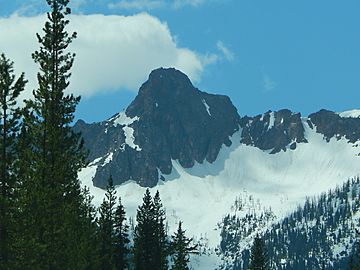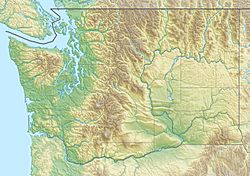Molar Tooth (Washington) facts for kids
Quick facts for kids Molar Tooth |
|
|---|---|

Molar Tooth seen from the road to Cutthroat Lake Trailhead
|
|
| Highest point | |
| Elevation | 7,547 ft (2,300 m) |
| Prominence | 427 ft (130 m) |
| Geography | |
| Location | Washington |
| Parent range | Cascade Range |
| Topo map | USGS Washington Pass |
| Type of rock | Granite |
| Climbing | |
| First ascent | September 19, 1971 by Alex Bertiulis with Charles and Patricia Raymond |
| Easiest route | Scrambling class 4 |
Molar Tooth is a mountain in Washington state, USA. It stands 7,547 feet (about 2,300 meters) tall and is made of strong granite rock. The mountain sits right on the border between Okanogan County and Skagit County.
Molar Tooth is part of the Okanagan Range, which is a smaller section of the much larger Cascade Range. You can find it within the Okanogan-Wenatchee National Forest. It's located south of Cutthroat Pass and just a short distance north of Cutthroat Peak, which is the closest taller mountain.
For climbers, the easiest way to reach the top is a type of climbing called scrambling (rated YDS 4). But if you're looking for a bigger challenge, there are also harder technical climbing routes (rated YDS 5) on its solid rock. Rain and melting snow from the east side of Molar Tooth flow into streams that eventually join the Methow River. Water from the west side drains into streams that lead to the Skagit River.
Weather at Molar Tooth
Molar Tooth is located in a marine west coast climate zone. This means it gets a lot of moisture from the Pacific Ocean. Most weather systems start over the Pacific and move northeast towards the Cascade Range.
As these weather systems hit the tall peaks of the North Cascades, the air is forced to rise. This process, called orographic lift, makes the air cool down and drop its moisture. This is why the western side of the North Cascades gets a lot of rain or snow, especially in winter.
During the winter, the weather is often cloudy. However, in the summer, high-pressure systems over the Pacific Ocean usually bring clear skies. Because of the ocean's influence, the snow here tends to be wet and heavy. This can create a high risk of avalanches, which are dangerous slides of snow down a mountain.
How Molar Tooth Was Formed
The North Cascades area has some of the most rugged and dramatic landscapes in the Cascade Range. You'll see jagged peaks, sharp ridges, and deep valleys carved by glaciers. These amazing features were created by geological events that happened millions of years ago.
These events caused big changes in the land's elevation, which also led to different climates across the Cascade Range. These climate differences then created various ecoregions, which are areas with unique plants and animals.
The Cascade Mountains began to form millions of years ago, during the late Eocene Epoch. This happened because the North American Plate (a huge section of Earth's crust) was slowly moving over the Pacific Plate. This movement caused many periods of volcanic activity.
Also, small pieces of Earth's crust, called terranes, came together to form the North Cascades about 50 million years ago. Molar Tooth itself is part of a large body of rock called the Golden Horn Batholith.
About two million years ago, during the Pleistocene period, huge sheets of ice called glaciers repeatedly moved across the land. As they advanced and retreated, they scraped and shaped the landscape, leaving behind piles of rock debris. The "U"-shaped valleys you see in the area today were carved out by these glaciers.
The combination of the land being pushed upwards (called uplift) and cracks forming in the Earth's crust (called faulting), along with the action of glaciers, has created the tall peaks and deep valleys of the North Cascades.
Images for kids





